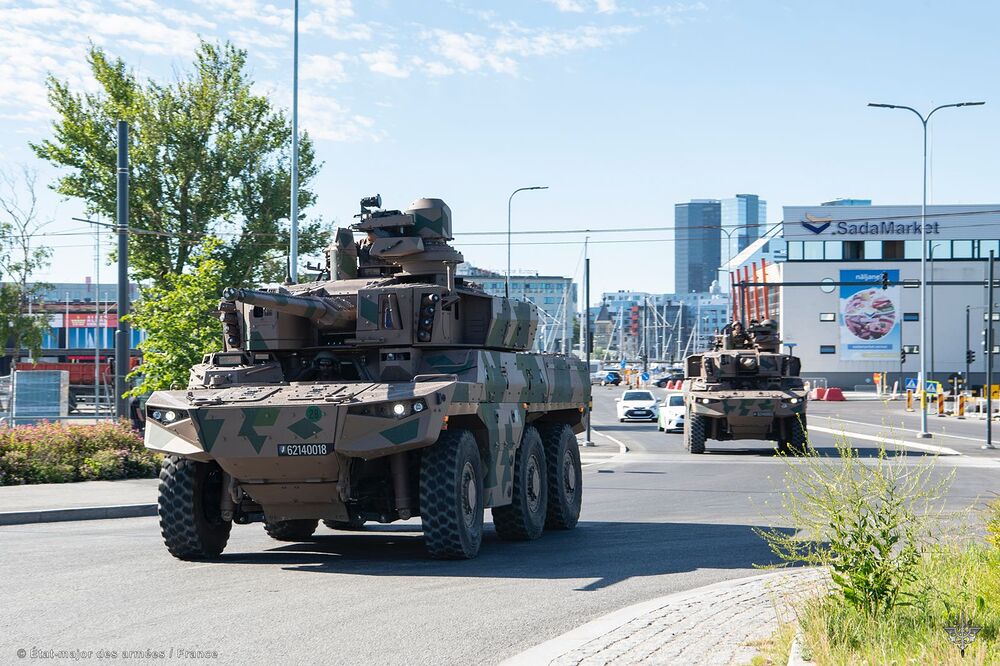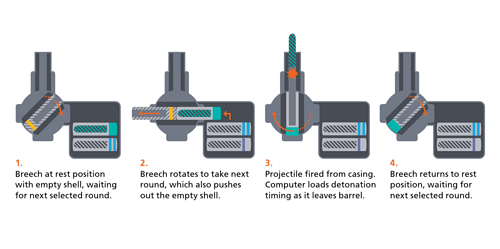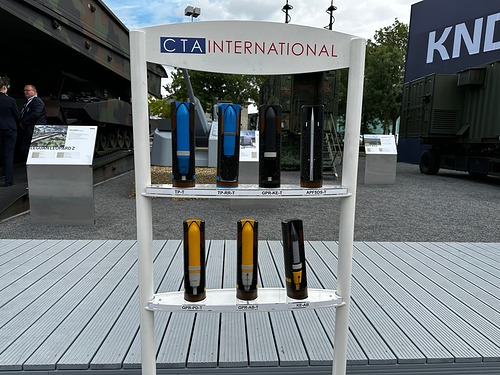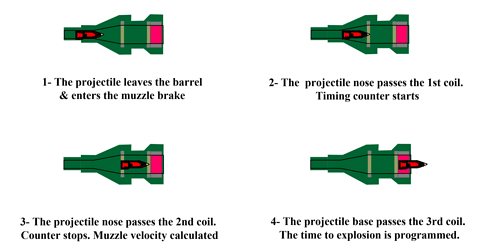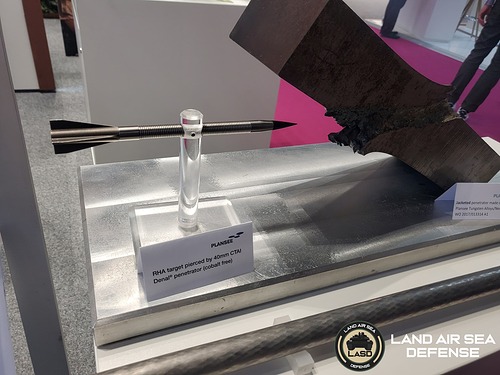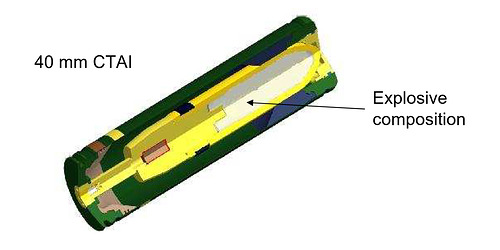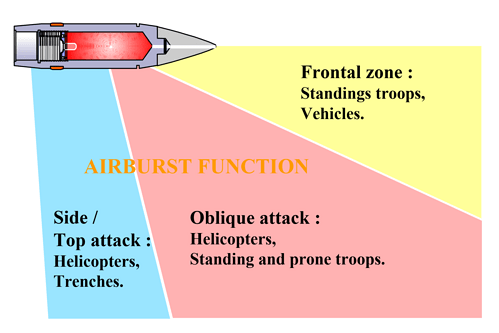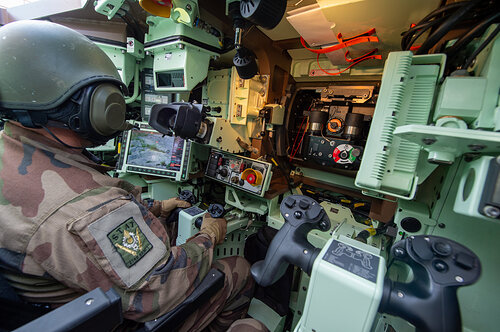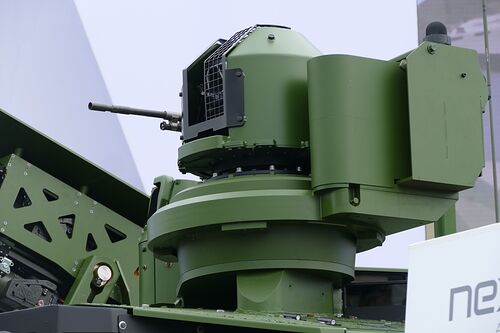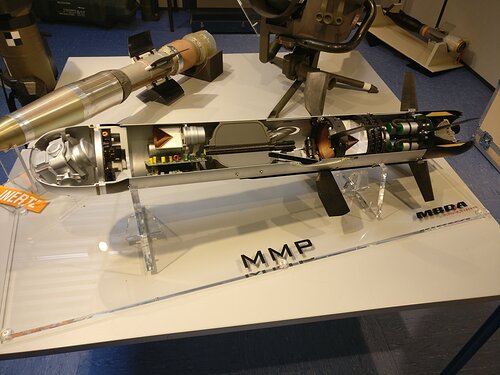Summary
- Combat weight:
- Basic configuration: 23.34t
- OPEX (with cage armour and mine protection kit): 24.7t
-
- Combat weight: 24.7t
- Number of crew: 3
- Size:
- Length: 7.1m (7.8m with cannon),
- Width: 2.99m (excluding rearview mirrors)
- Height: 2.8m (3.5m with RCWS)
- Turret traverse: 60°/sec,
- Main armament: 40 CTAS autocannon
- Calibre: 40mm,
- APFSDS
- Penetrator dimensions (without threading): 214.3mm length x 8.9mm diameter
- Initial velocity: 1600m/s
- Density: 17.55g/cm³
- Rate of fire: 200 rds/min
- Vertical traverse: -10° to +45°, 60°/sec
- Complementary armament: MMP ATGMs
- Penetration: >1,000mm CE – defeats all current generations of ERA
- Velocity: 200m/s
- Range: >5,000m
- Guidance:
- Fire and forget
- Optical guidance
- Antares DAL and DDM:
- IFOV: -15° to +75 x 360° in azimuth
- Laser warning receiver that can find range to emitter
- Missile departure detector: >8km range
- Also provides imaging for the crew
- Pilar V acoustic gunshot detector: <2,400m
- Top speed: 90 km/h
- Turning diameter: 15m
- Engine power: 500 hp @ 1700 rpm
- 4th generation gunner and commander thermals: 2x - 8x magnification
- 3rd generation driver thermals
Related Subjects
Spoiler
Suggestion
EBRC Jaguar: Reconnaissance Enters the Future - #41 by I_Love_Reisen
Jaguar Thread
EBRC Jaguar - #179 by pineappleguy05
Sensor polls
The EBRC Jaguar should come with new features modeled (MULTIPLE POLLS)
Bug Reports
Many bug reports including model, names… have been sent internally by @meumeu03 – Ask him for more information on his discord
Accepted
Jaguar missing 2 AKERON : Community Bug Reporting System
AKERON max range : Community Bug Reporting System
AKERON min range : Community Bug Reporting System
Jaguar missing hydropneumatic suspension : Community Bug Reporting System
LWS accuracy : Community Bug Reporting System
LWS Angles : Community Bug Reporting System
Hornet RCWS azimuth limits : Community Bug Reporting System
Hornet RCWS wrong elevation values : Community Bug Reporting System
Hornet RCWS wrong elevation speed : Community Bug Reporting System
Hornet RCWS is not stabilised : Community Bug Reporting System
Wrong 7.62mm name : Community Bug Reporting System
Wrong number of 7.62mm : Community Bug Reporting System
Driver missing thermal : Community Bug Reporting System
CTC 40 wrong elevation value : Community Bug Reporting System
CTC wrong elevation speed : Community Bug Reporting System
Engine wrong RPM : Community Bug Reporting System
Jaguar missing MAW : Community Bug Reporting System
APFSDS penetration : Community Bug Reporting SystemInfo Requested
APFSDS penetration : Community Bug Reporting SystemOpen
APFSDS Penetration : Community Bug Reporting SystemFixed
Denied
Jaguar Gunner Sight 4th gen thermal : Community Bug Reporting System
Jaguar Commander Sight 4th gen thermal : Community Bug Reporting System
Thermal Sensor Fusion (4th gen stuff) : Community Bug Reporting System
Ammo sensitivity : Community Bug Reporting System
Brief History
Spoiler
The EBRC Jaguar is a French armoured fighting vehicle developed by a consortium of KNDS France, Thales, and Arquus. “EBRC,” an acronym for “Engin Blindé de Reconnaissance et de Combat” defines the role in which it fulfills – reconnaissance and combat. The Jaguar constitutes one of three vehicles being introduced in Phase 1 of France’s Scorpion programme. Scorpion is a modernisation of the French army to transition it to a modern, digitised fighting force which prioritises collaborative warfare and “infovalorisation”. A total of 300 Jaguars are scheduled to replace the AMX 10 RCR, ERC 90 and VAB HOT – the latter two having already been withdrawn from service. The Jaguar fulfills the operational needs previously met by these vehicles but is further capable of meeting expanded needs to deliver in more diverse missions.
Despite the role of “EBRC” being first outlined in 1997, a functional prototype of this vehicle would not be revealed until 2018 and it was not until 2022 that this vehicle would enter service. As such, the EBRC Jaguar is the culmination of decades of exhaustive studies, not only for the construction of a new armoured vehicle but also the various technologies that accompany it. Due to the high level of integration of various advanced technologies, the EBRC Jaguar is perhaps the most sophisticated armoured vehicle today.
Deliveries of the EBRC Jaguar will occur over three standards knows as “rénoves,” with each introducing incremental upgrades. The first standard (Rénove 1), which was delivered to the French army in 2021, did not possess stabilisation for the main armament due to electrical problems and software issues.
In mid-2024, the R2 standard was delivered to the French army and all Jaguar R1s subsequently began being retrofitted to this new standard. Turret stabilisation was introduced with this iteration. Despite these upgrades, the R2 standard still does not fulfill the operational requirements established by the army for the EBRC programme. However, on 2nd May 2024, six Jaguars were sent on what would be the vehicle’s premier deployment to Estonia on the “Lynx” mission to participate in exercise Spring Storm 24. Speaking at the French senate, Chief of Army Pierre Schill stated this deployment took place because he considered Jaguar R2s ‘were at least on par with AMX 10 RCRs’ in terms of operational capabilities.
The final standard “R3” is expected to be qualified by the end of 2025 and delivered to the army the following year. This will introduce a beyond-line-of-sight (BLOS) targeting capability to the Jaguar. With the delivery of this new standard and its corresponding upgrades, the Jaguar will be deemed “operational” and therefore will assume the mission responsibilities of the AMX 10 RCR which will be retired from service by 2035.
A total of 150 Jaguars will be delivered to the French army by the end of 2025; meanwhile, the number of deliveries by 2030 has been reduced from 238 to 200. Deliveries of 300 EBRC Jaguar are scheduled to be completed by 2035, which will coincide with the remainder of the AMX 10 RCR fleet being retired. VAB HOTs and ERC 90 Sagaies were retired from service by 2016 and 2021 respectively. As of December 2024, there are 84 Jaguars in service with the French army.
Armament
Spoiler
The armament of the EBRC Jaguar was intended to be flexible: able to engage targets ranging from infantry to main battle tanks, within or beyond the vehicle’s line of sight. Early in the programme, a combination of a medium calibre autocannon and missiles were favoured due to a flexibility in integration with the remainder of the BOA network. However, it was also envisioned that a 105mm electromagnetic cannon could be integrated onto the EBRC in the future if the technology had reached maturity and surpassed various limitations present at the time. However, this idea has since been abandoned.
In 2010, the CTAS 40 autocannon was officially selected for the EBRC programme. MBDA France’s new MMP missile would also be selected for the programme following a submission to the DGA that same year. To accommodate this new weaponry, Nexter’s T40 manned turret was chosen. A remote-controlled weapons station from Arquus’s Hornet Business Unit would later be selected to complete the Jaguar’s offensive capabilities. With a combat weight of 3,800kg, the T40 turret accommodates the Jaguar’s armament, majority of its vetronics as well as the vehicle’s commander and gunner.
CTAS 40
Spoiler
The primary armament of the EBRC Jaguar is the CTAS 40 autocannon developed by Cased Telescoped Armament International (CTAI) – a joint venture between KNDS France and the United Kingdom’s BAE Systems. The CTAS 40 has a rifled barrel with a length of 70 calibres (2.8 metres) and a thermal sleeve for the Jaguar. The cannon uses a rotating breech ‘push-through’ mechanism wherein ammunition feed and exit occur along the same axis which is perpendicular (90°) to the cannon. This mechanism eliminates the need for linked ammunition, improving reliability and permits a significant reduction in the size of the weapon system.
Being the first cased telescope armament to enter service with a country, CTAS 40 differs from the conventional autocannons otherwise available. A traditional medium calibre cannon employs ammunition which has its propulsion fitted to the rear half of the projectile. In contrast, cased telescope ammunition (CTA) cartridges consist of a projectile which is entirely embedded in propellant, this permits an increase in both the volume and density of propellant used. According to CTAI, a reduction in bulk volume of 30% is attained whilst achieving greater terminal effects for an identical calibre.
Ammunition
Spoiler
CTA International has developed a suite of ammunition for the CTAS 40 which fulfils various functions. A total of seven rounds are offered by CTAI; of which, the anti-aerial air burst (A3B) is currently still in development.
During wartime, the ammunition natures currently employed by France include OFLT, BOAT, OET and its programmable sister – OET CHR. These are respectively known under the export designations: APFSDS-T, GPR-KE-T, GPR-PD-T, and GPR-AB-T.
For training purposes, the OXT (Obus d’eXercice Traceur) cartridge is used which reproduces the trajectory of both the OET as well as the BOAT rounds for its entire flight. OXT is known under the export designation “TP-T”. In addition, CTAI offers a ‘reduced range’ version of OXT known as “OXT GAB RED” (Obus d’eXercice Traceur Gabarit Réduit or TP-RR-T for export) which only reproduces the trajectory up to a distance of 1,200 metres and stops travelling at less than 3,500m.
The cased telescope cartridges for the CTAS 40 all share a common length of 255mm and diameter of 65mm. The programmable cartridges (OET CHR and PPM CHR) are programmed within the muzzle brake upon being fired.
Spoiler
Intended for defeating armoured vehicles, OFLT (Obus Flèche Traceur) is an armour-piercing fin-stabilised discarding sabot (APFSDS) round. According to KNDS France, OFLT is able to defeat a T-55 from a frontal aspect at a distance of 500m.
OFLT employs a tungsten penetrator with an initial length-to-diameter ratio of 24:1. The penetrator is developed by Plansee Tungsten Alloys (formerly Cime Bocuze) which has previously produced the tungsten and depleted uranium penetrators which have entered service with the French army. Compared to previous tungsten alloys used for kinetic energy penetrators, the tungsten alloy chosen for OFLT is cobalt-free. Despite the positive gain in mechanical properties obtained from the addition of cobalt, health concerns associated with exposure to cobalt has initiated a shift towards cobalt-free tungsten alloys. At this time this, such a shift has only taken place with medium calibre ammunition currently produced by KNDS France.
The APFSDS cartridge has an initial velocity of 1,600m/s despite using a less energetic low vulnerability (LOVA) propellant. OFLT has an effective range of over 3,000m and a dispersion of less than 0.3 NATO mils when firing at a rate of 80 rounds per minute, and less than 0.25mil with separate shots. The cartridge is also the lightest of all those offered by CTAI being 1,900g with a projectile weight of 730g.
Spoiler
CTA International has developed two high explosive (HE) cartridges for the CTAS 40. The first is OET (Obus Explosif Traceur), a HE round which detonates upon impact and a programmable version, OET CHR (Obus Explosif Traceur Chronométrique). Both OET and OET CHR contain 115g of the XP3264 insensitive explosive developed by Nexter Munitions (now KNDS Ammo France). This explosive charge is sufficient to perforate a 210mm thick reinforced concrete wall at 1,000m or generate splinters behind a 15mm thick armour such as can be found on lightly armoured vehicles.
In addition to the point detonating ability of OET, the OET CHR cartridge possesses an air burst capability. The mid-air explosion has a lethal area exceeding 125m² and the direction of air burst can be programmed according to the target.
Both OET cartridges have an effective range of 3,000m, an initial velocity of 1,000m/s and a dispersion of less than 0.4mil. Beyond this range, the cartridges can be set to self-destruct up to a distance of 6,000m.
Spoiler
Launched in 2007, development of the PPM CHR (Projectile Perforant Multiple Chronométrique) anti-aerial air burst (A3B) munition is still ongoing by KNDS France (then Nexter). The cartridge has a payload of over 200 tungsten pellets, each weighing 3.3 grams.

Primarily intended for use against airborne threats, the fire control system associated with the CTAS 40 recalibrates aiming of the cannon as well as the PPM CHR’s timed fuze after every round fired to account for the target’s speed and direction of travel. When the A3B munition nears the target, the tungsten pellet payload is released in the direction of its flight path to destroy it. In addition to use against aerial targets such as drones, helicopters and low-flying planes, the A3B round is also effective against infantry and for damaging vehicle optics and antennas. PPM CHR has an effective range of 4,000m against aerial targets with a dispersion of less than 0.4mil and a muzzle velocity of 900m/s.
PPM CHR is currently at Technology Readiness Level 5 and is expected to reach full operational capability in 2027. A first batch of 500 PPM CHR cartridges have already been ordered by the DGA; however, these are destined for the RAPIDFire system which is already in service with the French navy.
Onboard the Jaguar
Spoiler
The CTAS 40 is stabilised in both azimuth and elevation which permits firing on the move. The cannon covers a vertical arc of -10° to 45° which is sufficient to target the second floor of a building; however, extension up to 85° is possible due to the cannon’s low swept volume and a recoil stroke of only 42mm. Due to the cannon’s minimal intrusion, it increases the space in the turret compartment for the crew to operate.
A consequence of the cannon’s forward position is that it impairs stabilisation. Therefore, CTAI develops a specific stabilisation system for the CTAS 40 referred to as the “Gun Control Equipment” or (GCE). The GCE is further responsible for the rotation of the turret in azimuth and rotation of the cannon in elevation, both at a maximum speed of 60° per second onboard the Jaguar.
Loading of the CTAS 40 is carried out using the Ammunition Handling System (AHS). For the EBRC Jaguar, the weapon has a 63 round ready rack, and an additional 120 rounds are stowed onboard. The ammunition feed is located to the right of the cannon, on the commander’s side of the turret. Cartridges are handfed into the AHS by the commander one at a time. With inspiration from the autoloader found on the Leclerc, the various ammunition natures are kept track of using barcodes found along the base of the cartridges. Switching between ammunition natures occurs in less than three seconds.
Hornet S
Spoiler
The Hornet S (also referred to as Hornet T3) is a remote-controlled weapon system (RCWS) developed by Arquus’s Hornet Business Unit in cooperation with Safran Electronics & Defense – the latter providing the optronics. This serves as the secondary armament for the EBRC Jaguar to engage threats with greater rapidity than the CTAS 40 or for threats where the main armament would otherwise be undue and excessive.
The weapons station is mounted on the roof of the EBRC Jaguar. The combination of remote-controlled machine gun and panoramic sight in a single unit preserves space for the Jaguar’s other sensors which are mounted on the roof. It traverses 360° in azimuth at a maximum speed of 90° per second and in elevation from -20° to +60° at a maximum speed of 70° per second. This provides ample speed to react to threats and sufficient pointing angles for urban environments.
Hornet S employs a 7.62 x 51mm MAG 58 machine gun produced by Belgium’s FN Herstal. The MAG 58 is belt-fed, and 550 rounds are carried on the Hornet S. An additional 2,200 rounds are stowed inside the Jaguar. The machine gun has a fire rate of 650 – 1,000 rounds per minute.
The weapons station is stabilised in two axes, whilst the Paseo sight is itself independently stabilised. The Hornet S is fully integrated with and facilitates the functionality of the Paseo sensor.
MMP
Spoiler
The MMP (Missile Moyenne Portée) or “Akeron MP” (as it is known on the export market) is a fifth generation anti-tank guided missile (ATGM) developed by MBDA France. To complement its other weaponry, the EBRC Jaguar possesses a retractable ATGM launcher containing two MMPs which can be immediately fired upon the launcher being deployed. The missiles have a range exceeding 5,000m and a multi-effects warhead to defeat a variety of targets.
In 2022, the MMP was renamed for export purposes to Akeron MP. However, the original designation is retained within the French armed forces. Outside of the Scorpion programme, the MMP is being procured by Egypt, Greece and Sweden; the latter will cooperate on future developments of the missile.
Characteristics
The MMP uses a smokeless dual stage propulsion developed by Roxel France. This consists of a booster for cold launch before a sustainer propels the missile to a velocity of 200m/s. Aerodynamic control surfaces enable the MMP to glide to distances of over 5,000m. Upon crew selection, the MMP can assume either a low altitude, direct trajectory or a high altitude, top attack trajectory to engage its target.
Man-in-the loop capability is achieved through a high speed fibre optic datalink which provides in-flight control and relays imaging from the MMP’s dual band imaging seeker until the moment of impact. Developed by Safran Electronics & Defense, the missile’s seeker consists of an uncooled MWIR channel and a daytime channel providing colour imaging. The seeker can be independently used to acquire targets using either of its channels, or acquisition can be performed using the Jaguar’s Paseo sight which is fully integrated with the missile.
Due to an inertial navigation system, MMPs are able to fired towards a set of designated coordinates, whereupon the seeker will acquire a threat either autonomously or by the man-in-the-loop capability. This capability has already been validated using a Novadem NX70 drone.
The MMP features a multi-purpose tandem warhead developed by Saab Bofors Dynamics Switzerland. The warhead is effective against armoured vehicles, structures and infantry. For armoured vehicles, the warhead is able to penetrate over 1,000mm of rolled homogenous armour and the DGA has validated the effectiveness of the warhead against the latest generation explosive reactive armour.
Onboard the Jaguar, an additional two missiles are stored. The MMPs are stored within a tube within the retractable launcher; upon reloading, the now-empty tubes are replaced with news ones containing missiles. A drawback to the Jaguar’s missile launching capability is that MMPs cannot be reload from under-armour; instead, a crew member is forced to exit the Jaguar to replenish the retractable launcher.
Sensors
Spoiler
The EBRC Jaguar employs a diverse suite of innovative sensors which maximise situational awareness and survivability. Collectively, these sensors provide warning and localisation of threatening missiles, lasers and gunfire, as well as monitors the vehicle surroundings for hostiles.
The primary sensors of the Jaguar are the gunner and commander’s separate Paseo multispectral sights with fourth generation thermal imaging. In the event of malfunction, both have access to back-up direct optical sights in the event of malfunction. These optronics are used to operate the vehicle’s weaponry and search the battlefield.
Similarly, the driver can directly view outside through periscopes mounted on their hatch or a vision enhancement (DVE) sight which is situated to their left. Supplied by Bertin Technologies, the Jaguar’s DVE consists of both a daytime and infrared channel providing a wide field of view in front of the vehicle. The periscopes have image intensification from Photonis, meanwhile the infrared sight is based on a third generation Pico Gen2 LWIR microbolometer from ULIS (now a part of Lynred).
Additional daytime proximity cameras are placed on vehicle’s tail as well as a set of two above the front wheels on either side. These can be used to monitor the Jaguar’s immediate vicinity by the commander or gunner, or by the driver to manoeuvre the vehicle.
Imaging and information from the optronics and sensors are supplied to the crew through digital displays from IRTS. These displays also facilitate operation of the Scorpion battlefield management system (SICS).
In the future, data from the various onboard sensors will be amalgamated to form a comprehensive system optimising automated threat detection and response. Development of such a system is being carried out within the framework of PTD Pronoia.
Pilar V
Spoiler
Pilar V is the latest generation of acoustic gunshot detector developed by Metravib. First seeing saw deployment with United Nations peacekeeping forces in Sarajevo, Metravib’s acoustic gunshot detectors are now in service with 30 countries including France, the US and UK, and have since been deployed to other combat zones.
Pilar V consists of four omnidirectional microphones arranged in a tetrahedron, each of which can be readily replaced. Each microphone separately measures the acoustic waves emitted by the muzzle blast when a weapon is fired, as well as the shockwave of the projectile as it travels along its trajectory. If a projectile shockwave is registered within a certain proximity to the microphones, the location of the shooter can be triangulated. Given both the shockwave and muzzle blast are registered, Pilar V records the trajectory of the projectile and provides a direction accuracy of within 2° in azimuth and within 3° in elevation. The range to the source of the threat is found to within 10% by measuring the time elapsed between the microphones registering the shockwave and then the muzzle blast.
A single acoustic gunshot detector achieves a detection rate exceeding 95% against supersonic projectiles over a wide spectrum of threats from rifles to 120mm cannons; RPGs to ATGMs. Each threat is classified according to calibre by analysing and comparing the signature of the projectile’s shockwave against a known threat database. The crew receives all information within a second of initial detection.
Threat localisation (especially in built-up areas) and detection rate can be further improved by fusing data from nearby gunshot detectors. If at least two arrays detect a muzzle blast but no shock wave (the threat is shooting away from the arrays) or only the shock waves are detected (the muzzle blast occurs outside the detection range of the arrays), the three-dimensional position of the shooter can still be obtained.
Onboard the Jaguar, Pilar V is integrated with the GPS and inertial navigation system to record the position of a shooter in relation to the vehicle even whilst the vehicle is itself moving. The acoustic system also filters out noise generated by the Jaguar to not produce false alarms, including outgoing fire. Through interfacing with the SICS network, outgoing from friendly units is also ignored.
Antares
Spoiler
To enhance the situational awareness, two Antares hyper-hemispherical cameras are mounted on the roof of the EBRC Jaguar. Day and nighttime imaging is provided by visible near-infrared (Vis-NIR) CMOS detector which produces an image with a 5.5 megapixel resolution. This image covers 360° in azimuth and a vertical arc between -15° to +75. To improve identification capability, Antares is able to zoom in on a target. Using a combination of image processing and video motion detection, Antares alerts the crew of the Jaguar to various threats:
In an urban environment, a lone shooter can be detected up to 150m away at an elevation of up to 25m, or a moving armoured vehicle is detected up to 500m away. However, in an open field where the scene is significantly less cluttered, the detection range for an armoured vehicle increases up to 1,500m. IEDs (improvised explosive devices) as small as a few tens of centimetres are able to be detected by Antares a few tens of metres away from the vehicle, meanwhile a UAV with a diameter of a meter are able to be detected at a distance of up to 250m.
The Vis-NIR detector shares an aperture with a SWIR detector which is sensitive to the 0.9 – 1.7µm region of the infrared spectrum. This enable Antares to detect laser sources (such as rangefinders and designators) which typically operate at 1.02µm and 1.5µm. Due to being able to sense which pixel absorbs the most radiation from the laser source, the direction of the threat is able to be established within an accuracy of 1.5°. The distance to the laser emitter is measured with a guaranteed accuracy of within 3%, although less than 6 metres in most cases.
Muzzle flashes and missile plumes all radiate peak energy in the SWIR band. As such, these are able to be detected by the SWIR sensor in Antares. The energy radiated by a missile launch is sufficient such that it can be detected by Antares beyond the typical ranges which missiles pose a threat, at least 8km. Through using the same SWIR-based detection method, gunfire can also be detected. Large calibre cannon muzzle blasts are detected at similar ranges to missile plumes.
Mobility
Spoiler
During the conceptualisation of the EBRC Jaguar, it was envisioned that this vehicle would have comparable mobility to the VBCI – an 8 x 8 armoured vehicle of similar weight. Arquus, which had previously developed the drivetrain for the VBCI now develops that of the Jaguar.
Before being delivered to KNDS France, the Jaguar’s drivetrain is assembled at Arquus’s Centre d’Excellence de Production de Véhicules Neufs in Limoges, drawing upon various components produced elsewhere:
The Jaguar is powered by a militarised Volvo D11 inline six cylinder turbo-diesel engine which outputs 500hp at 1,700rpm and 2,475Nm torque at 1,200rpm. The engine has a displacement of 10.8L. Connected to the engine is a ZF EcoLife transmission with 7 forward and 2 reverse gears. The Jaguar reaches a governed top speed of 90km/h and has an autonomy of 800km.
Power is transferred to three independent axles, with the forward and rear being directional. Whilst travelling on the road, the middle axle can be disengaged to reduce fuel consumption. The Jaguar has a turning radius of 15 metres. To optimise the performance of the Jaguar to various terrains, hydropneumatic suspension developed by Quiri enables the ride height of the Jaguar to be adjusted and run-flat tires which are managed by a central tire inflation system.
Protection
Spoiler
The tactical employment of the EBRC Jaguar prioritises rapid deployment and mobility: trading significant armour for a relatively low weight. However, the afforded protection can be considered relatively sufficient against expected threats, although currently lacking in certain aspects.
Constructed from an aluminium body, composite materials are selectively integrated such that the Jaguar is able to achieve STANAG 4569 level 5. This corresponds to defence from 25mm APFSDS across its frontal arc from a distance of 500m, as well as 14.5mm heavy machine gun fire from all directions in azimuth. To improve its defence against RPGs, particularly for the urban combat zones where the Jaguar can be deployed, the EBRC can be fitted with the ‘PG-Guard’ statistical protection grid (more commonly referred to as “cage armour”) produced by KNDS France. This is claimed to have a 50-65% probability of defeating garden variety RPG-7s. In the future, the Prometeus active protection system will be integrated which will significantly improve the Jaguar’s defence against RPGs as well as ATGMs.
The emergent and prevalent threat of improvised explosive devices (IEDs) during French operations in the 2000s became a paramount concern for the Scorpion programme. Particular attention was paid to the Jaguar’s (as well as the Griffon’s) underbody: a reinforced underbody and high ground clearance mitigates damage from IEDs. An additional mine protection kit weighing approximately one tonne is required to be mounted to provide protection from 10kg explosives – this is used in the Jaguar’s OPEX configuration.
In addition to the protection against explosives provided by the vehicle structure, the Jaguar is further equipped with an Eclipse counter-IED system developed by Thales. Eclipse creates a bubble around the vehicle which jams all frequencies compatible with the CONTACT radio used in SICS, ensuring that there is no disruption to communications. Eclipse inhibits radio signals used to activate RC-IEDs; however, it is also able to jam civilian UAV data links to counter drone threats.
GALIX
Spoiler
Soft-kill protection is provided by GALIX grenades produced by Lacroix Defense and KNDS France. GALIX was first developed in the late 1980s by GIAT. First introduced on the Leclerc main battle tank, GALIX has become a mainstay for the French army.
Lacroix Defense offers a range of grenades compatible with the Jaguar. However, during wartime, the two grenades employed by the French army are the GALIX 4 and GALIX 13. The latter provides screening of the vehicle within a second of deployment, masking it in the visible to longwave infrared spectrum: 0.4 – 14µm. Meanwhile GALIX 4 is a ‘self-defence’ grenade which consists of two sub-payloads containing blast and fragmentation charges, this serves to eliminate infantry threats within a 175 metre radius of the vehicle.
During peacekeeping operations, the GALIX 19 serves as a warning for crowds, when discharged, the grenades emit a sound of between 157dB to 163dB. In addition, the GALIX 46 is used to disperse crowds and prevent encirclement, producing a loud sound and irritant smoke.
In the future, the protection of the Jaguar will be improved upon with the introduction of the aforementioned Prometeus active protection system, as well as Cameleon adaptive multispectral camouflage and Pronoia. These projects are all currently under development.
References
Majority of the information comes from primary sources. However, the amount of sources used are much too numerous to be feasibly shared here. However, they can be supplied directly to the developers by @Mulatu_Astatke upon request.
